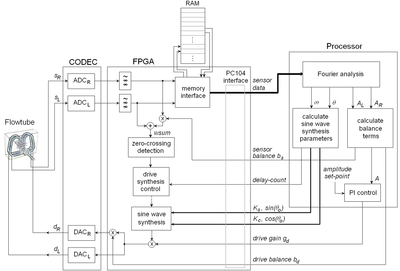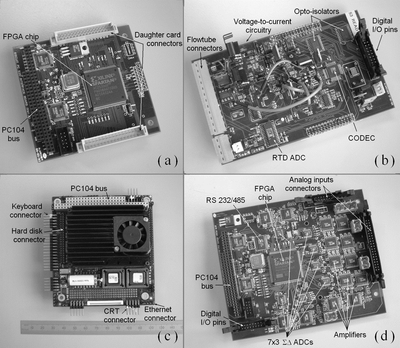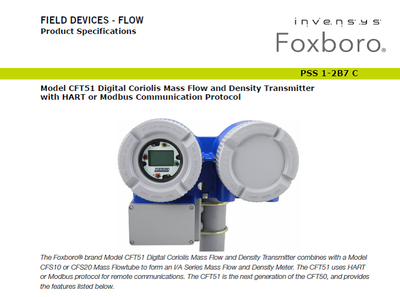Digital Drive, Coriolis research, Advanced Instrumentation Research Group
Digital Drive
The operation of a Coriolis mass flow meter is dependent upon the proper oscillation of the flowtube. This is controlled by the drive signal(s) generated by the transmitter. The oscillation of the flowtube (as indicated by the sensor signals) is typically sinusoidal and hence characterized in terms of frequency, phase and amplitude. The drive signal is also often sinusoidal, or at least a regular waveform (e.g. square wave) for which similar attributes can be defined: the frequency, phase (relative to the sensor signal) and amplitude of the drive signal need to be determined and generated for optimal operation of the flowtube. A commonly-used criterion for optimal operation is that the flowtube should oscillate at its natural frequency of vibration, at a fixed amplitude. As measurement algorithms assume constant amplitude of oscillation over the calculation interval (typically 5 – 500ms), amplitude stability is relevant for measurement quality.
For oscillation at the natural frequency, it is necessary for the driving force to be 90º out of phase with the motion of vibration. Conveniently, the most commonly used sensor, based on an electromagnetic coil, measures velocity, hence the sensor signal is 90º out of phase with the motion of the flowtube. Thus an optimal drive signal has the same frequency of oscillation and phase as the sensor signal, with a drive amplitude selected to maintain a constant sensor amplitude.
Matching the drive output to the exact phase of the sensor signal is challenging. With small levels of phase offset, and with benign process conditions, the consequences are small –the drive signal power requirement increases. With more significant phase offset between driver and sensor, the flowtube oscillation becomes forced rather than natural, the drive energy requirement become significantly higher, and the drive frequency can drift away from its natural value. Finally, with large phase offset the meter may cease vibrating entirely (“stalling”), or begin to oscillate in another mode of vibration, typically at a frequency where the phase offset between driver and sensor is closer to an integral multiple of 360 degrees. Analogous issues are seen in power electronics design: for sinusoidal inputs and outputs, digital delay in the control circuitry can lead to inefficiencies.
The most common technique for generating a drive signal has been analog positive feedback, whereby the sensor signal (containing the desired frequency and phase characteristics) is multiplied by a drive gain factor (either by analog or digital means). The drive gain required to maintain the desired amplitude of oscillation is proportional to the mechanical damping on the flowtube. Assuming negligible delay in the analog feedback circuitry, this approach ensures phase matching between sensor input and drive output. Positive feedback is straightforward to implement, but it provides only partial control of the drive waveform, and cannot prevent unwanted components in the sensor signal (e.g. other modes of vibration) from being fed back into the drive signal. In particular, in the presence of two-phase flow, drive systems based on analog feedback are prone to stalling. The mechanical damping on the flowtube rises by two orders of magnitude with two-phase flow, and this damping varies rapidly. Most analog drive systems are unable to track and respond to damping under two-phase flow. Some designs have a maximum drive gain which, if exceeded by the damping, leads to catastrophic collapse in oscillation. High and variable damping leads to low and variable sensor amplitudes, and it is possible to lose track of the sensor signals, especially if they are contaminated with other modes of vibration.
An all-digital drive system [1] avoids many of the pitfalls associated with analog positive feedback. The alternative approach presented in this paper is drive waveform synthesis, whereby the transmitter generates the drive waveform digitally, for example a pure sine wave or square wave, with the required amplitude, frequency and phase characteristics, in order to provide a highly adaptable and precise drive signal. This has several advantages over positive feedback, including full control over the drive waveform, and an ability to maintain operation even in two-phase flow, but the challenge is to match the phase of the sensor signal in real time given the inevitable delays of a digital implementation.
The UTC has been developing digital Coriolis transmitters for over fifteen years. A key enabling technology has been the Field Programmable Gate Array (FPGA). The resulting transmitters provide platforms for a range of innovative developments in both the research laboratory and industrial applications. For example:
- The dynamic response of the meter can be measured by the time required to indicate a step changes in flow. This transmitter has demonstrated a response time of 4ms, between 1 and 2 orders of magnitude faster than other reported Coriolis meters. This has found industrial application in, for example, short proving runs for custody transfer applications, and filling applications.
- The two-phase problem (the “dirty little secret” of Coriolis meters) has been transformed into a useful two-phase measurement capability, with numerous industrial applications, paticularly in the oil and gas sector.
Over 20 US and UK patents have been granted based on this transmitter technology (e.g. [2],[3]).

Digital Drive Functionality (from [1])

Digital Transmitter Hardware (from [1])

Part of CFT-51 Specification Sheet - a commercial product based on the UTC digital drive
References
[1] Zamora, ME, H, and Henry, MP. “Digital Control of a Coriolis Mass Flow Meter”, IEEE Transactions on Industrial Electronics, Vol. 55, No. 7, July 2008.
[2] Henry, MP & Zamora, ME: “Startup Techniques for a Digital Flowmeter”. US Patent No. 7,904,256, Mar 2011.
[3] Henry, MP & Zamora, ME: “Drive Techniques for a Digital Flowmeter”. UK Patent No. 2,428,090, Feb 2007.
